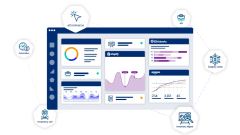Work In Process Inventory: A Detailed Guide
The flow of content:
| Work in process - a definition |
| Work in process formula |
| Difference between work in process and work in progress |
Once the manufacturer gets the raw materials in-house, the process for making the finished products begins. The inventory in the process of turning into finished products from raw materials is called work in process inventory.
Let’s look at some popular definitions of the term and dive deeper into its significance.
What is Work in Process (WIP)?
According to Wikipedia,
“Work-in-process is a company's partially finished goods waiting for completion and eventual sale or the value of these items. The term is used in production and supply chain management.”
As per the Merriam-Webster dictionary,
“Work-in-process (WIP) refers to a component of a company's inventory that is partially completed. The value of that partially completed inventory is sometimes also called goods in process on the balance sheet (particularly if the company is manufacturing tangible items rather than providing services).”
So then what is WIP Inventory? WIP inventory includes all costs incurred during the production process before a product is fully assembled and ready for sale.
Work in Process vs Work in Progress
Though both these terms are used interchangeably, their meaning differs in business terminology. Here are some of the major differences between work in process and work in progress:
- Work in process typically refers to unfinished products in manufacturing that are still being transformed into finished goods and can be tracked in accounting records. On the other hand, work in progress is a term more commonly used in construction to describe projects like buildings that are still under development.
- Work in process involves items that are close to becoming finished products. For example, a bakery with 50 batches of bread in production or a tailor with 5 suits cut but not yet sewn would count these as work in process. In contrast, work in progress usually refers to projects that take a longer time to complete—like a building with 3 floors completed out of 25 planned floors.
- The term work in process mainly describes physical products. Meanwhile, work in progress has a broader meaning and can apply to services, ongoing assignments, home renovations, and even relationships.
Benefits of Well-Managed WIP Inventory
Effectively managing your WIP inventory gives your business valuable insight. Here’s how:
Improves Capital Management
WIP inventory represents funds invested in products still in production. By tracking WIP carefully, companies can understand exactly how much capital is tied up and make smarter decisions about cash flow and purchasing.
Enhances Financial Reporting Accuracy
WIP inventory accuracy ensures your financial statements reflect the true value of assets. This prevents errors in cost of goods sold calculations and helps maintain reliable budgeting forecasts.
Prevents Cash Flow Challenges
Mismanaged WIP can hide production bottlenecks or excess inventory that drain resources. Keeping WIP under control helps avoid unexpected cash flow issues and keeps operations running smoothly.
Optimizes Production Flow
Closely monitoring WIP helps identify bottlenecks in your production process, enabling quicker fixes. This leads to smoother operations, shorter lead times, and faster delivery of finished products to customers.
Accounting for Work in Process Inventory
Beyond its role in production, WIP inventory is also a key financial metric, classified as a current asset on a company's balance sheet.
WIP inventory includes:
- Raw materials – Cost of materials used in production but not yet finished.
- Labor costs – Wages paid to employees working on production.
- Overhead expenses – Utilities, factory rent, equipment maintenance, etc.
Work in Process Formula
It is essential for any manufacturing company to know the exact amount of inventory they hold whether it is in terms of raw materials or work in process inventory. Inventory management helps in counting and maintaining all kinds of inventory. Tracking the accurate number of inventory by regularly counting the stock will give the manufacturer a fair idea of how much needs to be produced and also help in forecasting the production as per the demand.
To calculate this, one must refer to the balance sheet of the previous quarter, month, or year to get the required details.
To get the work in process inventory, you need to use the following formula:
Beginning work in process amount + manufacturing costs - cost of manufactured goods
<H3> Calculating WIP Inventory Example <H3>
For instance, let's look at a company called Crown Industries who is manufacturing furniture.
As per the previous year’s balance sheet, Crown Industries has $8,000 worth of beginning work in process inventory and incurred $240,000 of manufacturing costs. Their total worth of finished goods is $238,000.
Therefore, as per the formula,
8,000+ 240,000 - 238,000 = 10,000
This means that Crown Industries has $10,000 work in process inventory with them.
However, by using this formula, you can only get an estimate of the work in process inventory. For the exact value of work in process inventory, you need to calculate it manually.
Manual vs. Automated WIP Inventory Tracking
While formulas provide an estimate of WIP inventory, manufacturers should manually track inventory to ensure precision in financial reporting and cost management. Manual inventory tracking helps identify:
- Spoilage and material waste
- Production delays affecting inventory flow
- Scrap losses and defective goods
Consider this example: A textile manufacturer finds that $2,000 worth of fabric was damaged during production. If this isn’t recorded in WIP calculations, the company’s financial reports may be inaccurate.
One of the advantages of calculating it manually is that you can add expenses like the cost of scrap, spoilage of raw material, etc. which are all visible during physical counting.
Why Automating WIP Inventory Management is Beneficial
For better accuracy and efficiency, manufacturers are increasingly using automated inventory management systems. Here's why you need an inventory management system with automated features:
- Real-time inventory tracking prevents errors in financial reports.
- AI-powered demand forecasting helps optimize WIP stock levels.
- Integration with accounting software ensures accurate reporting on the balance sheet.
Take Control of Your WIP Inventory with Cin7
Effectively managing your work in process inventory is key to maintaining smooth production, controlling costs, and improving cash flow. By gaining real-time visibility into your WIP, you can make smarter decisions that keep your operations efficient and your finances accurate.
With Cin7, you get a powerful inventory management system that tracks every stage of your production process—helping you monitor WIP, optimize resource use, and get clear insights into your capital tied up in unfinished goods. Ready to streamline your manufacturing and boost profitability? Learn more in our inventory management guide and discover how Cin7 can simplify your WIP management with inventory intelligence today.




